Geography > AS Mark Scheme > GCE Geography H481/01: Physical systems Advanced GCE Mark Scheme for Autumn 2021 (All)
GCE Geography H481/01: Physical systems Advanced GCE Mark Scheme for Autumn 2021
Document Content and Description Below
Oxford Cambridge and RSA Examinations GCE Geography H481/01: Physical systems Advanced GCE Mark Scheme for Autumn 2021Oxford Cambridge and RSA Examinations OCR (Oxford Cambridge and RSA) is a le... ading UK awarding body, providing a wide range of qualifications to meet the needs of candidates of all ages and abilities. OCR qualifications include AS/A Levels, Diplomas, GCSEs, Cambridge Nationals, Cambridge Technicals, Functional Skills, Key Skills, Entry Level qualifications, NVQs and vocational qualifications in areas such as IT, business, languages, teaching/training, administration and secretarial skills. It is also responsible for developing new specifications to meet national requirements and the needs of students and teachers. OCR is a not-for-profit organisation; any surplus made is invested back into the establishment to help towards the development of qualifications and support, which keep pace with the changing needs of today’s society. This mark scheme is published as an aid to teachers and students, to indicate the requirements of the examination. It shows the basis on which marks were awarded by examiners. It does not indicate the details of the discussions which took place at an examiners’ meeting before marking commenced. All examiners are instructed that alternative correct answers and unexpected approaches in candidates’ scripts must be given marks that fairly reflect the relevant knowledge and skills demonstrated. Mark schemes should be read in conjunction with the published question papers and the report on the examination. © OCR 2021Mark Scheme October 2021 5 H481/01 1. Annotations Annotation Meaning Highlight Off page comment Omission Indicates a whole answer for which there is no credit Rubric error (place at start of Question not being counted) Level 1 Level 2 Level 3 A01 point made A02 point made Development of a point Irrelevant; a significant amount of material that does not answer the question Point has been seen and noted Place specific detail Highlighting an issue e.g. irrelevant paragraph. Use in conjunction with another stamp e.g IRRL Must be used on all blank pages where there is no candidate response Correct – for objective points based mark schemes Benefit of the DoubtH481/01 Mark Scheme October 2021 6 2. Subject Specific Marking Instructions INTRODUCTION Your first task as an Examiner is to become thoroughly familiar with the material on which the examination depends. This material includes: • the specification, especially the assessment objectives • the question paper and its rubrics • the mark scheme. You should ensure that you have copies of these materials. You should ensure also that you are familiar with the administrative procedures related to the marking process. These are set out in the OCR booklet Instructions for Examiners. If you are examining for the first time, please read carefully Appendix 5 Introduction to Script Marking: Notes for New Examiners. Please ask for help or guidance whenever you need it. Your first point of contact is your Team Leader. USING THE MARK SCHEME Please study this Mark Scheme carefully. The Mark Scheme is an integral part of the process that begins with the setting of the question paper and ends with the awarding of grades. Question papers and Mark Schemes are developed in association with each other so that issues of differentiation and positive achievement can be addressed from the very start. This Mark Scheme is a working document; it is not exhaustive; it does not provide ‘correct’ answers. The Mark Scheme can only provide ‘best guesses’ about how the question will work out, and it is subject to revision after we have looked at a wide range of scripts. The Examiners’ Standardisation Meeting will ensure that the Mark Scheme covers the range of candidates’ responses to the questions, and that all Examiners understand and apply the Mark Scheme in the same way. The Mark Scheme will be discussed and amended at the meeting, and administrative procedures will be confirmed. Co-ordination scripts will be issued at the meeting to exemplify aspects of candidates’ responses and achievements; the coordination scripts then become part of this Mark Scheme. Before the Standardisation Meeting, you should read and mark in pencil a number of scripts, in order to gain an impression of the range of responses and achievement that may be expected.H481/01 Mark Scheme October 2021 7 In your marking, you will encounter valid responses which are not covered by the Mark Scheme: these responses must be credited. You will encounter answers which fall outside the ‘target range’ of Bands for the paper which you are marking. Please mark these answers according to the marking criteria. Please read carefully all the scripts in your allocation and make every effort to look positively for achievement throughout the ability range. Always be prepared to use the full range of marks. LEVELS OF RESPONSE QUESTIONS: The indicative content indicates the expected parameters for candidates’ answers, but be prepared to recognise and credit unexpected approaches where they show relevance. Using ‘best-fit’, decide first which set of level descriptors best describes the overall quality of the answer. Once the level is located, adjust the mark concentrating on features of the answer which make it stronger or weaker following the guidelines for refinement. Highest mark: If clear evidence of all the qualities in the level descriptors is shown, the HIGHEST Mark should be awarded. Lowest mark: If the answer shows the candidate to be borderline (i.e. they have achieved all the qualities of the levels below and show limited evidence of meeting the criteria of the level in question) the LOWEST mark should be awarded. Middle mark: This mark should be used for candidates who are secure in the level. They are not ‘borderline’ but they have only achieved some of the qualities in the level descriptors. Be prepared to use the full range of marks. Do not reserve (e.g.) highest level marks ‘in case’ something turns up of a quality you have not yet seen. If an answer gives clear evidence of the qualities described in the level descriptors, reward appropriately. Quality of extended response will be assessed in questions marked with an (*). Quality of extended response is not attributed to any single assessment objective but instead is assessed against the entire response for the question.H481/01 Mark Scheme October 2021 8 AO1 AO2 AO3 Quality of extended response Comprehensive A wide range of detailed and accurate knowledge that demonstrates fully developed understanding that shows full relevance to the demands of the question. Precision in the use of question terminology. Knowledge and understanding shown is consistently applied to the context of the question, in order to form a: Clear, developed and convincing analysis that is fully accurate. Clear, developed and convincing interpretation that is fully accurate. Detailed and substantiated evaluation that offers secure judgements leading to rational conclusions that are evidence based. Quantitative, qualitative and/or fieldwork skills are used in a consistently appropriate and effective way and with a high degree of competence and precision. There is a well-developed line of reasoning which is clear and logically structured. The information presented is relevant and substantiated. Thorough A range of detailed and accurate knowledge that demonstrates well developed understanding that is relevant to the demands of the question. Generally precise in the use of question terminology. Knowledge and understanding shown is mainly applied to the context of the question, in order to form a: Clear and developed analysis that shows accuracy. Clear and developed interpretation that shows accuracy. Quantitative, qualitative and/or fieldwork skills are used in a suitable way and with a good level of competence and precision. There is a line of reasoning presented with some structure. The information presented is in the most-part relevant and supported by some evidence.H481/01 Mark Scheme October 2021 9 AO1 AO2 AO3 Quality of extended response Detailed evaluation that offers generally secure judgements, with some link between rational conclusions and evidence. Reasonable Some sound knowledge that demonstrates partially developed understanding that is relevant to the demands to the question. Awareness of the meaning of the terms in the question. Knowledge and understanding shown is partially applied to the context of the question, in order to form a: Sound analysis that shows some accuracy. Sound interpretation that shows some accuracy. Sound evaluation that offers generalised judgments and conclusions, with limited use of evidence. Quantitative, qualitative and/or fieldwork skills are used in a mostly suitable way with a sound level of competence but may lack precision. There information has some relevance and is presented with limited structure. The information is supported by limited evidence. Basic Limited knowledge that is relevant to the topic or question with little or no development. Confusion and inability to deconstruct terminology as used in the question. Knowledge and understanding shows limited application to the context of the question in order to form a: Simple analysis that shows limited accuracy. Simple interpretation that shows limited accuracy. Quantitative, qualitative and/or fieldwork skills are used inappropriately with limited competence and precision. The information is basic and communicated in an unstructured way. The information is supported by limited evidence and the relationship to the evidence may not be clear.H481/01 Mark Scheme October 2021 10 AO1 AO2 AO3 Quality of extended response Un-supported evaluation that offers simple conclusions. Question Answer Mark Guidance 1 (a) Explain how geology influences coastal landscape systems. Level 3 (6-8 marks) Demonstrate thorough knowledge and understanding of how geology influences coastal landscape systems (AO1). This will be shown by including well-developed ideas with a clear appreciation of the influence of geology on coastal landscape systems. Level 2 (3-5 marks) Demonstrate reasonable knowledge and understanding of how geology influences coastal landscape systems (AO1). This will be shown by including developed ideas with some appreciation of the influence of on coastal landscape systems. Level 1 (1-2 marks) Demonstrate basic knowledge and understanding of how geology influences coastal landscape systems (AO1). 8 AO1 x8 Indicative content: AO1 – 8 marks Knowledge and understanding of how geology influences coastal systems could potentially include: • influence will vary across different coastal landscape systems • lithology - weak rocks eroding quickly producing deep bays, more resistant rocks eroding slowly resulting in headlands • cracks/joints in rocks provide weaknesses which can be exploited by waves, such as erosion by hydraulic action undercutting the base of cliffs • structure e.g. concordant and discordant coastlines influencing wave refraction and the location of concentrated or dispersed wave energy • dip of rocks influence cliff profiles allowing formation of near vertical cliff faces if horizontally bedded or gently sloping cliff faces if dipping seawards • reference to inputs, stores, processes and outputsH481/01 Mark Scheme October 2021 11 This will be shown by including simple ideas with no or limited appreciation of the influence of geology on coastal landscape systems. 0 marks No response or no response worthy of credit. Level 3 answers will show understanding of the operation of the coastal landscape system and concepts such as dynamic equilibrium. 1 (b) (i) Study Fig. 1 which shows sources of global coastal sediment. Using evidence from Fig. 1, comment on the usefulness of this data presentation technique. The pie chart: • has only 3 segments so easy to read () • is a widely used technique so easily recognised () • is unable to show change over time () • is unable to show patterns of how these sources change over space () • pie chart does not tell us the total amount of sediment () 3 AO3 x3 AO3 – 3 marks 3 x 1 mark () • Credit positive and negative features of the usefulness of this technique • Must have evidence from the Fig. for max. 1 (b) (ii) Using evidence from Fig. 1, describe the pattern shown. • terrestrial accounts for the majority of coastal sediment () • offshore and human sources contributing a minor amount () • Use of data to support description e.g. human and offshore accounting for 5%, terrestrial accounting for 95% (). 3 AO3 x3 AO3 – 3 marks 3 x 1 mark () • Must have evidence from the Fig. for max. • Allow a reasonable degree of error in dataH481/01 Mark Scheme October 2021 12 1 (b) (iii) With reference to Fig. 1, explain one way in which this distribution may change in the future. • Offshore sources may reduce further () as sea levels rise(DEV) and sediment is no longer transported into the near shore (DEV). • Terrestrial sources may increase further () as rates of deforestation and soil erosion increase (DEV) leading to increased sediment entering coastal system through fluvial sources (DEV) • Terrestrial sources may decrease () as management limits erosion (DEV) and therefore rates of sediment supply into fluvial sources e.g. use of channelization, drains, culverts or dams (DEV) 3 AO2 x3 AO2 – 3 marks 1 x 1 mark (), 2 x 1 mark (DEV) • Identifying how the distribution may change () • Analysis to explain why (DEV) 1 (c) ‘The changes caused by human activity in coastal landscapes are always negative’. Discuss. AO1 Level 3 (6-8 marks) Demonstrates comprehensive knowledge and understanding of the changes caused by human activity in coastal landscapes. The answer should include accurate place-specific detail. Level 2 (3-5 marks) Demonstrates thorough knowledge and understanding of the changes caused by human activity in coastal landscapes. The answer should include place-specific detail which is partially accurate. 16 AO1 x8 AO2 x8 Indicative content AO1 – 8 marks Knowledge and understanding of the changes caused by human activity in coastal landscapes could potentially include: • Examples of human activity in coastal landscapes could include coastal management, dredging, ports, resource extraction and so on • Unforeseen negative effects of human activity e.g. impact on processes and flows of material, processes or energy, changing landforms or consequences of these • The human activity can be a result of deliberate management of a coastal system or in pursuit of economic developmentH481/01 Mark Scheme October 2021 13 Level 1 (1-2 marks) Demonstrates basic knowledge and understanding of the changes caused by human activity in coastal landscapes There is an attempt to include place-specific detail but it is inaccurate. 0 marks No response or no response worthy of credit. AO2 Level 3 (6-8 marks) Demonstrates comprehensive application of knowledge and understanding to provide clear and developed analysis that shows accuracy to provide a detailed evaluation that offers generally secure judgements, with some link between rational conclusions and evidence, of the relative importance of negative changes caused by human activity in coastal landscapes. Level 2 (3-5 marks) Demonstrates thorough application of knowledge and understanding to provide sound analysis that shows some accuracy to provide a sound evaluation that offers generalised judgements and conclusions, with limited use of evidence, of the relative importance of negative changes caused by human activity in coastal landscapes. Level 1 (1-2 marks) Demonstrates basic application of knowledge and understanding to provide simple analysis that shows limited accuracy to provide an un-supported evaluation that offers simple conclusions of the relative importance AO2 – 8 marks Apply knowledge and understanding to analyse and evaluate the relative importance of negative changes caused by human activity in coastal landscapes could potentially include: • May evaluate spatial, temporal or in contrast to foreseen, negative or positive effects. • Positive effects e.g. reduced erosion, improvement of biodiversity after creation of salt marshes or increase in beach width following installation of groynes e.g. Sandbanks • Negative effects always occur because we fail to understand complexity of the coastal landscape system e.g. increased erosion downdrift causing cliff collapse or mass movement, loss of sediment due to extraction at Mangawhai-Pakiri, change in beach profile increasing vulnerability to erosion. This has led to flooding and breaching of the Mangawhai spit during 1978 storms. • Analysis in relation to impact on social, environment or economy would be relevantH481/01 Mark Scheme October 2021 14 of negative changes caused by human activity in coastal landscapes. 0 marks No response or no response worthy of credit. Quality of extended response Level 3 There is a well-developed line of reasoning which is clear and logically structured. The information presented is relevant and substantiated. Level 2 There is a line of reasoning presented with some structure. The information presented is in the most-part relevant and supported by some evidence. Level 1 The information is basic and communicated in an unstructured way. The information is supported by limited evidence and the relationship to the evidence may not be clear.H481/01 Mark Scheme October 2021 15 Question Answer Mark Guidance 2 (a) Explain how geology influences glaciated landscape systems. Level 3 (6-8 marks) Demonstrate thorough knowledge and understanding of how geology influences glaciated landscape systems (AO1). This will be shown by including well-developed ideas with a clear appreciation of the influence of geology on glaciated landscape systems. Level 2 (3-5 marks) Demonstrate reasonable knowledge and understanding of how geology influences glaciated landscape systems (AO1). This will be shown by including developed ideas with some appreciation of the influence of geology on glaciated landscape systems. Level 1 (1-2 marks) Demonstrate basic knowledge and understanding of how geology influences glaciated landscape systems (AO1). This will be shown by including simple ideas with no or limited appreciation of the influence of geology on glaciated landscape systems. 0 marks No response or no response worthy of credit. 8 AO1 x8 Indicative content: AO1 – 8 marks Knowledge and understanding of how geology and climate will influence glaciated systems could potentially include: • influence will vary across different glaciated landscape systems. • lithology e.g. resistant rock such as basalt produces prominent landforms including arêtes and pyramidal peaks which have eroded slowly over time • rocks with faults and joints can be exploited by weathering processes such as freeze-thaw causing them to weaken more quickly and aid more rapid erosion • resistant outcrops on the valley floor may have their up-valley side smoothed by abrasion due to increased pressure melting, and their downvalley side steepened by plucking due to pressure release; rouche moutonnée form as a result. • structure e.g. varying rock resistance can lead to a stepped profile in U- shaped valleys where weaker rocks have been eroded by rapidly by abrasion and more resistant rocks eroded more slowly • reference to inputs, stores, processes and outputs Level 3 answers will show understanding of the operation of the glaciated landscape system and concepts such as dynamic equilibrium.H481/01 Mark Scheme October 2021 16 2 (b) (i) Study Fig. 2 which shows types of global glaciated and periglacial landscapes. Using evidence from Fig. 2, comment on the usefulness of this data presentation technique. The pie chart: • has only 3 segments so easy to read () • is a widely used technique so easily recognised () • is unable to show change over time () • is unable to show patterns of how these sources change over space () • pie chart does not tell us the total amount of area () 3 AO3 x3 AO3 – 3 marks 3 x 1 mark () • Credit positive and negative features of the usefulness of this technique • Must have evidence from the Fig. for max. 2 (b) (ii) Using evidence from Fig. 2, describe the pattern shown. • periglacial is the most common type of cold environment landscape shown () • followed by ice sheets and then valley glaciers and ice caps contributing the smallest proportion () • Use of data to support description e.g. periglacial 59%, ice sheets 40% and valley glaciers and ice caps 1% (). 3 AO3 x3 AO3 – 3 marks 3 x 1 mark () • Must have evidence from the Fig. for max. • Allow a reasonable degree of error in dataH481/01 Mark Scheme October 2021 17 2 (b) (iii) With reference to Fig. 2, explain one way in which this distribution may change in the future. • Permafrost coverage will change according to changes in seasonal patterns () e.g. an increase in the length and temperatures of the summer season as global warming occurs (DEV) causes permafrost thaw and a reduction in the extent of the coverage (DEV) • The proportion of ice sheets may decrease () if global warming causes increased rates of melting, especially in the summer (DEV) causing large sections to calf/break off e.g. Larson Ice Shelf (DEV) • The proportion of valley glaciers may decrease () as entire glacial systems disappear with increased global temperatures (DEV) causing both rapid melting and higher velocity flows into the oceans (DEV) 3 AO2 x3 AO2 – 3 marks 1 x 1 mark (), 2 x 1 mark (DEV) • Identification of how distribution may change () • Analysis to explain why (DEV) 2 (c)* ‘The changes caused by human activity in glaciated landscapes are always negative’. Discuss. AO1 Level 3 (6-8 marks) Demonstrates comprehensive knowledge and understanding of the changes caused by human activity in glaciated landscapes. The answer should include accurate place-specific detail. Level 2 (3-5 marks) 16 AO1 x8 AO2 x8 Indicative content AO1 – 8 marks Knowledge and understanding of the changes caused by human activity in glaciated landscapes could potentially include: • Examples of human activity in glaciated landscapes includes construction, energy extraction, tourism • Unintentional negative effects of human activity e.g. impact on processes and flows, changing landforms e.g. thawing of permafrost or increased channel scourH481/01 Mark Scheme October 2021 18 Demonstrates thorough knowledge and understanding of the changes caused by human activity in glaciated landscapes. The answer should include place-specific detail which is partially accurate. Level 1 (1-2 marks) Demonstrates basic knowledge and understanding of the changes caused by human activity in glaciated landscapes. There is an attempt to include place-specific detail but it is inaccurate. 0 marks No response or no response worthy of credit. AO2 Level 3 (6-8 marks) Demonstrates comprehensive application of knowledge and understanding to provide clear and developed analysis that shows accuracy to provide a detailed evaluation that offers generally secure judgements, with some link between rational conclusions and evidence, of the relative importance of negative changes caused by human activity in glaciated landscapes Level 2 (3-5 marks) Demonstrates thorough application of knowledge and understanding to provide sound analysis that shows some accuracy to provide a sound evaluation that offers generalised judgements and conclusions, with limited use of evidence, of the relative importance of negative changes caused by human activity in glaciated landscapes. • Possible successful conservation / management strategies / afforestation / slope control • The human activity can affect either periglacial or glaciated landscape systems AO2 – 8 marks Apply knowledge and understanding to analyse and evaluate the relative importance of negative changes caused by human activity in glaciated landscapes could potentially include: • May evaluate spatial, temporal or in contrast to foreseen, negative or positive effects. • Positive effects e.g. ability to construct underground which reduces impact on the surface e.g. pumping stations and power plants of Grande Dixence Dam • Unintentional negative effects always occur because we fail to understand complexity of the glacial landscape system e.g. Grande Dixence Dam caused change in sedimentation as during purges increased sediment is released into the system, otherwise it is much reduced. Creation of thermokarst and alases in Alaska or increased solifluction in active layer • Negative impacts range in scale e.g. impact of oil drilling in Alaska very difficult to find positive impacts on landscape at all. Release of energy causing increased melting has severe local effects and flaring has far reaching global effects • Analysis in relation to impact on social, environment or economy would be relevantH481/01 Mark Scheme October 2021 19 Level 1 (1-2 marks) Demonstrates basic application of knowledge and understanding to provide simple analysis that shows limited accuracy to provide an un-supported evaluation that offers simple conclusions of the relative importance of negative changes caused by human activity in glaciated landscapes. 0 marks No response or no response worthy of credit. Quality of extended response Level 3 There is a well-developed line of reasoning which is clear and logically structured. The information presented is relevant and substantiated. Level 2 There is a line of reasoning presented with some structure. The information presented is in the most-part relevant and supported by some evidence. Level 1 The information is basic and communicated in an unstructured way. The information is supported by limited evidence and the relationship to the evidence may not be clear.H481/01 Mark Scheme October 2021 20 Question Answer Mark Guidance 3 (a) Explain how geology influences dryland landscape systems. Level 3 (6-8 marks) Demonstrate thorough knowledge and understanding of how geology influences dryland landscape systems (AO1). This will be shown by including well-developed ideas with a clear appreciation of the influence of geology on dryland landscape systems. Level 2 (3-5 marks) Demonstrate reasonable knowledge and understanding of how geology influences dryland landscape systems (AO1). This will be shown by including developed ideas with some appreciation of the influence of geology on dryland landscape systems. Level 1 (1-2 marks) Demonstrate basic knowledge and understanding of how geology influences dryland landscape systems (AO1). This will be shown by including simple ideas with no or limited appreciation of the influence of geology on dryland landscape systems. 0 marks No response or no response worthy of credit. 8 AO1 x8 Indicative content: AO1 – 8 marks Knowledge and understanding of how geology and climate influence dryland landscape systems could potentially include: • influence will vary across different dryland landscape systems • lithology may limit the water transfer in drainage basins e.g. semi-arid Badlands, South Dakota, USA where impermeable silt and clay bedrock creates rapid run-off with little soil development, limited vegetation and evapotranspiration • the rapid run-off, especially when highly charged with sediment due to the lack of binding from any vegetation roots, is very abrasive and able to erode channels such as wadis and canyons • rocks that are highly permeable, e.g. pumice in central Iceland, allow rapid drainage creating a surface that is dry and devoid of vegetation. • well-jointed rocks e.g. on the limestone plateau of the Causses in southern France, allow rapid percolation which leaves the surface dry and streamless with limited vegetation apart from sparse, coarse grasses • reference to inputs, stores, processes and outputs Level 3 answers will show understanding of the operation of the dryland landscape system and concepts such as dynamic equilibrium.H481/01 Mark Scheme October 2021 21 3 (b) (i) Study Fig. 3 which shows types of global dryland landscapes. Using evidence from Fig. 3, comment on the usefulness of this data presentation technique. The pie chart: • has only 3 segments so easy to read () • is a widely used technique so easily recognised () • is unable to show change over time () • is unable to show patterns of how these sources change over space () • pie chart does not tell us the total amount of area () 3 AO3 x3 AO3 – 3 marks 3 x 1 mark () • Credit positive and negative features of the usefulness of this technique • Must have evidence from the Fig. for max. 3 (b) (ii) Using evidence from Fig. 3, describe the pattern shown. • semi-arid environment is the largest type () • mid- & low-latitude accounts for twice as much as polar environments () • polar is the smallest type • Use of data to support description e.g. semi-arid 76%, mid- & low-latitude 15%, polar 9% (). 3 AO3 x3 AO3 – 3 marks 3 x 1 mark () • Must have evidence from the Fig. for max. • Allow a reasonable degree of error in data 3 (b) (iii) With reference to Fig. 3, explain one way in which this distribution may change in the future. • Polar deserts may decrease () as climate change is predicted to increase precipitation and temperatures in high latitudes (DEV) increasing 3 AO2 x3 AO2 – 3 marks 1 x 1 mark (), 2 x 1 mark (DEV) • Identification of how distribution may change () • Analysis to explain why (DEV)H481/01 Mark Scheme October 2021 22 moisture availability and allowing more soil and vegetation to develop (DEV) • Mid- and Low-latitude deserts may increase () as desertification continues to spread polewards (DEV) which may be due to increased population and human activity such as overgrazing or overcultivation (DEV) • Mid- and low-latitude deserts (and/or semi-arid environments) may increase () as climate change causes rainfall events to become less frequent (DEV) but higher in intensity which causes soil erosion and contributes to desertification (DEV) 3 (c)* ‘The changes caused by human activity in dryland landscapes are always negative’. Discuss. AO1 Level 3 (6-8 marks) Demonstrates comprehensive knowledge and understanding of the changes caused by human activity in dryland landscapes. The answer should include accurate place-specific detail. Level 2 (3-5 marks) Demonstrates thorough knowledge and understanding of the changes caused by human activity in dryland landscapes. The answer should include place-specific detail which is partially accurate. Level 1 (1-2 marks) 16 AO1 x8 AO2 x8 Indicative content AO1 – 8 marks Knowledge and understanding of changes caused by human activity in dryland landscapes could potentially include: • Examples of human activity may include tourism, modifying water supplies, dams and so on • Unintentional negative effects of human activity e.g. water supply issues, drought, sediment shortage – ‘scour and fill’, increased erosion, degradation sand bars, exposure to wind erosion • The human activity can be a result of deliberate management of a water supply issue or in pursuit of economic developmentH481/01 Mark Scheme October 2021 23 Demonstrates basic knowledge and understanding of the changes caused by human activity in dryland landscapes. There is an attempt to include place-specific detail but it is inaccurate. 0 marks No response or no response worthy of credit. AO2 Level 3 (6-8 marks) Demonstrates comprehensive application of knowledge and understanding to provide clear and developed analysis that shows accuracy to provide a detailed evaluation that offers generally secure judgements, with some link between rational conclusions and evidence, of the relative importance of negative changes caused by human activity in dryland landscapes. Level 2 (3-5 marks) Demonstrates thorough application of knowledge and understanding to provide sound analysis that shows some accuracy to provide a sound evaluation that offers generalised judgements and conclusions, with limited use of evidence, of the relative importance of negative changes caused by human activity in dryland landscapes. Level 1 (1-2 marks) Demonstrates basic application of knowledge and understanding to provide simple analysis that shows limited accuracy to provide an un-supported evaluation that offers simple conclusions of the relative importance of negative changes caused by human activity in dryland landscapes. AO2 – 8 marks Apply knowledge and understanding to analyse and evaluate the relative importance of negative changes caused by human activity in dryland landscapes could potentially include: • May evaluate spatial, temporal or in contrast to foreseen, negative or positive effects. • Positive effects e.g. moderation of the system so there is less flooding and fewer periods of low flow moderating the water supply • Unintentional negative effects always occur because we fail to understand complexity of the dryland landscape system e.g. Glen Canyon Dam reducing sediment downstream and leading to the erosion of sand bars as well as the growth of debris fans into Glen Canyon as they are no longer eroded by the floods. • Tourism and livestock farming in SE Utah causes long term widespread damage to cryptobiotic crusts causing increased wind and water erosion and the loss of biodiversityH481/01 Mark Scheme October 2021 24 0 marks No response or no response worthy of credit. Quality of extended response Level 3 There is a well-developed line of reasoning which is clear and logically structured. The information presented is relevant and substantiated. Level 2 There is a line of reasoning presented with some structure. The information presented is in the most-part relevant and supported by some evidence. Level 1 The information is basic and communicated in an unstructured way. The information is supported by limited evidence and the relationship to the evidence may not be clear.H481/01 Mark Scheme October 2021 25 Question Answer Mark Guidance 4 (a) (i) Study Fig. 4 which shows a satellite image of phytoplankton blooms in the Bay of Biscay. Using evidence from Fig. 4, identify three limitations of this data presentation technique. • Fig 4. doesn’t have a scale to determine size () • Fig 4. Doesn’t have key to allow interpretation of the colours () • Lack of colour distinction between different shades of blue on Fig. 4 () • Lack of locational information on Fig. 4 such as coastal towns or landmarks for reference () • Photo is a snapshot in time and not able to show change () 3 AO3 x3 AO3 – 3 marks 3 x 1 () for identification of three limitations of this data presentation technique • Allow any appropriate limitation • Must have evidence from the Fig. for max. 4 (a) (ii) With reference to Fig. 4, suggest two ways the phytoplankton bloom would influence the carbon cycle. • Increase absorption of carbon dioxide from atmosphere () reducing the atmospheric store while photosynthesising during the day (DEV) • Increase in atmospheric store at night () release of CO2 back into atmosphere through respiration (DEV) • Availability of increased food source () (phytoplankton) may attract larger numbers of herbivores and therefore predators which would decrease phytoplankton and see increase rates of respiration. (DEV) • Carbon moved from fast carbon to slow carbon cycle () due to sinking of phytoplankton to the ocean floor (DEV) 4 AO2 x4 AO2 – 4 marks 2 x 1 () for stating a way the bloom would influence the carbon cycle. 2 x 1 (DEV) for application of knowledge to explain influence on the carbon cycle. Must have two ways for max – candidate may achieve 2 x (DEV) for first pointH481/01 Mark Scheme October 2021 26 4 (b) Examine how water extraction influences flows and stores in the water cycle. Level 3 (7-10 marks) Demonstrates comprehensive knowledge and understanding of water extraction and the water cycle (AO1). Demonstrates thorough application of knowledge and understanding to provide a detailed evaluation of the influence of water extraction on the water cycle (AO2). This will be shown by including well-developed ideas of the influence of water extraction on the water cycle. Level 2 (4-6 marks) Demonstrates thorough knowledge and understanding of water extraction and the water cycle (AO1). Demonstrates reasonable application of knowledge and understanding to provide a detailed evaluation of the influence of water extraction on the water cycle (AO2). This will be shown by including developed ideas of the influence of water extraction on the water cycle. Level 1 (1–3 marks) Demonstrates basic knowledge and understanding of water extraction and the water cycle (AO1). Demonstrates basic application of knowledge and understanding to provide an evaluation of the influence of water extraction on the water cycle (AO2). 10 AO1 6 AO2 4 Indicative content AO1 – 6 marks Knowledge and understanding of water extraction and flows and stores of the water cycle could potentially include: • Water extraction o Extraction from surface and groundwater sources to meet public, industrial and agricultural demand o Groundwater extracted for public supply from aquifers by wells and boreholes e.g. River Kennet supplying Swindon’s population. Focus near urban centres and is spatially uneven. o Removal of water for industrial purposes e.g. from groundwater sources beneath London under artesian pressure o Around 300million m3yr-1 is used for agricultural use in the UK, around half for irrigation and all extracted from surface or ground sources. This removes ~1.5% of fresh water in the UK. This varies spatially across the country o Some countries e.g. Cyprus remove significant amounts of fresh water from limited sources to facilitate tourism • Flows and stores in the water cycle o Fall / rise of water table o Flow rates in channels, soil, bedrock o Stores of water on the surface, in the soil and aquifers AO2 – 4 marksH481/01 Mark Scheme October 2021 27 This will be shown by including some ideas about the influence of water extraction on the water cycle. 0 marks No response or no response worthy of credit. Apply knowledge and understanding to provide a detailed evaluation of the influence of water extraction on the water cycle could potentially include: • Comments may relate to spatial and/or temporal variation in scale of change • Range of changes may also be commented on, including, perhaps, both positive and negative changes • Locational contexts may be provided, and although these are not required by the question, they may help the answer • Rates of extraction exceeding recharge creating a falling water table and lower river flows e.g. River Kennet decreased by 10-14% • Lower flows reducing flooding and wetland areas within catchment basins • Springs and seepages dry up reducing incidence of saturated overland flow on chalk in Kennet’s drainage basin • In central London overexploitation of groundwater led to 90m fall in water table in 1900-1950, reducing store under artesian pressure and springs on North Downs and Chilterns • Colorado River, USA stopped flowing into the sea due to increased abstraction for urban centres, reducing channel storage and flow 4 (c) Assess the impact of long-term climate change on the water and carbon cycles. AO1 Level 3 (6–8 marks) Demonstrates comprehensive knowledge and understanding of the impacts of long-term climate change on the water and carbon cycles. 16 AO1 8 AO2 8 Indicative content AO1 – 8 marks Knowledge and understanding of the impact of longterm climate change could potentially include: • Water cycle o Increased evaporation therefore more water vapour in the atmosphereH481/01 Mark Scheme October 2021 28 The answer should include accurate place-specific detail. Level 2 (3–5 marks) Demonstrates thorough knowledge and understanding of the impacts of long-term climate change on the water and carbon cycles. The answer should include some place-specific detail which is partially accurate. Level 1 (1–2 marks) Demonstrates basic knowledge and understanding of the impacts of long-term climate change on the water and carbon cycles. There is an attempt to include place-specific detail but it is inaccurate. 0 marks No response or no response worthy of credit. AO2 Level 3 (6-8 marks) Application of knowledge and understanding is comprehensive. Analysis is clear, developed and convincing. Evaluation of the impacts of long-term climate change on the water and carbon cycles is detailed and substantiated. Judgements are secure and evidence based leading to rational conclusions. Level 2 (3-5 marks) Application of knowledge and understanding is reasonable. Analysis is sound with some development that is mostly relevant. Evaluation of the impacts of long-term climate change on the water and carbon o Feedback helping to raise temperatures, leading to increased evaporation and precipitation o Increased precipitation leader to greater flood risks o Increased condensation, leading to increased release of latent heat, increasing risk of hurricanes and midlatitude storms o Increased melting of glaciers and permafrost shrinking storage in cryosphere o Long term changes in the water cycle with reference to glacial/interglacial periods • Carbon cycle o Higher temperatures increase rates of decomposition and weathering, increasing transfers of carbon from biosphere to atmosphere o Tropics may be drier leading to lower carbon stores as forests replaced by grasslands o Higher latitudes boreal forests extend polewards o Carbons in permafrost released as temperatures rise o Acidification of oceans reduce photosynthesis limiting capacity of ocean as store o Increased of store in atmosphere, decrease in biosphere o Long term changes in the carbon cycle with reference to glacial/interglacial periodsH481/01 Mark Scheme October 2021 29 cycles is sound but partial. Judgements are generalised with some use of evidence leading to appropriate conclusions. Level 1 (1-2 marks) Application of knowledge and understanding is basic. Analysis is simple with little or no development. Evaluation of the impacts of long-term climate change on the water and carbon cycles is weak or absent. Judgements, if present, are unsupported leading to simple conclusions. 0 marks No response or no response worthy of credit. Quality of extended response Level 3 There is a well-developed line of reasoning which is clear and logically structured. The information presented is relevant and substantiated. Level 2 There is a line of reasoning presented with some structure. The information presented is in the most-part relevant and supported by some evidence. Level 1 The information is basic and communicated in an unstructured way. The information is supported by limited evidence and the relationship to the evidence may not be clear. AO2 – 8 marks Apply knowledge and understanding to analyse and evaluate the impact could potentially include: o impact as measured by humans in terms of cost e.g. increased risk of flooding, hurricane or midlatitude storm o impact measured by change in ecosystem e.g. growth of boreal forests poleward, changing landscape and habitat completely o impact measured by scale e.g. by size of store, e.g. ocean sink largest store of carbon so decrease of this has a bigger influence than change of vegetation as land plants are a significantly smaller store o Significance of glacial periods may be greater due to length of time period compared to interglacial o assessment may involve comments of the differences and/or similarities in impacts on the two cycles o expect wide range of justification, accept any relevant arguments.OCR (Oxford Cambridge and RSA Examinations) The Triangle Building Shaftesbury Road Cambridge CB2 8EA [Show More]
Last updated: 1 year ago
Preview 1 out of 28 pages

Reviews( 0 )
Document information
Connected school, study & course
About the document
Uploaded On
Oct 10, 2022
Number of pages
28
Written in
Additional information
This document has been written for:
Uploaded
Oct 10, 2022
Downloads
0
Views
58








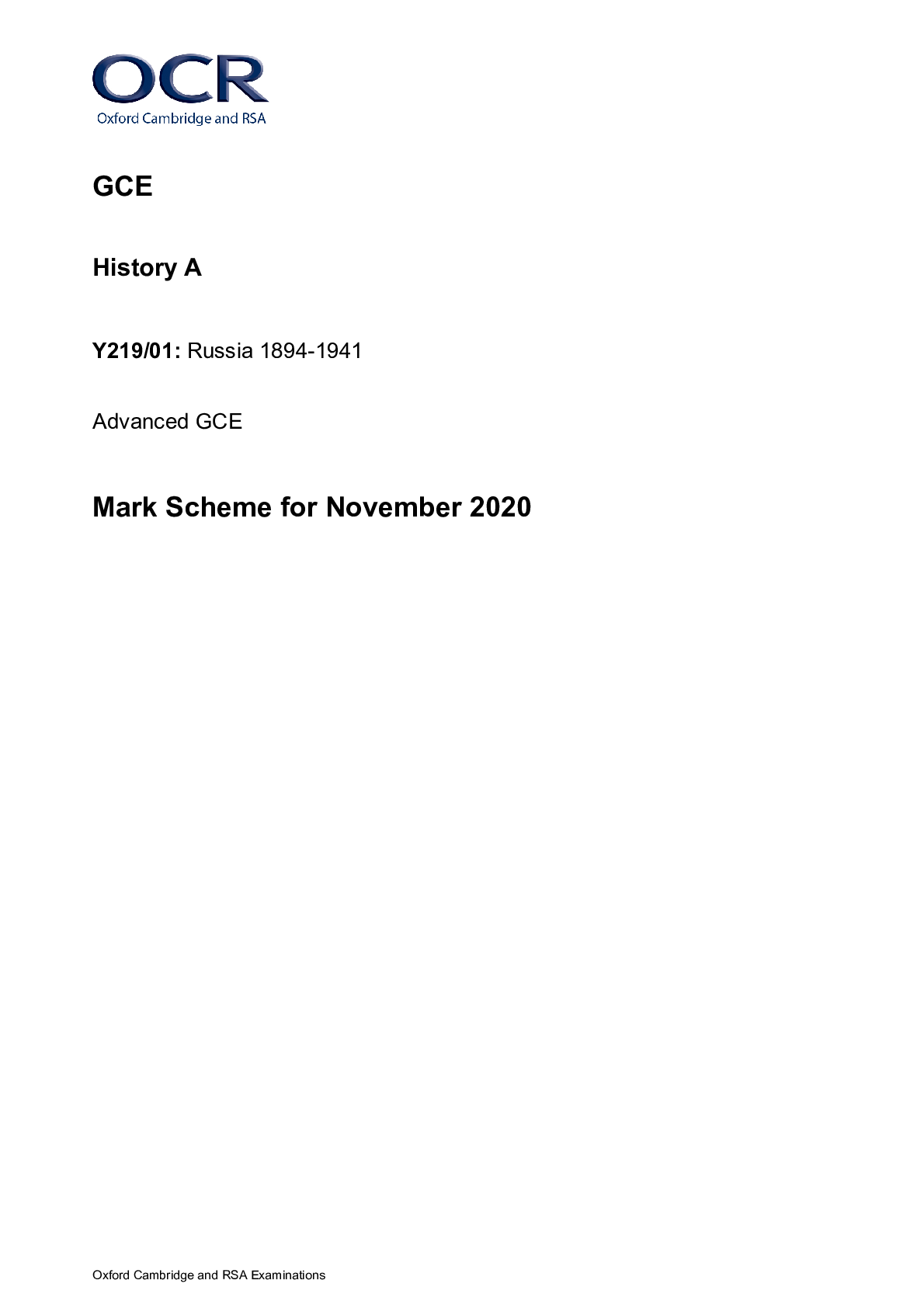
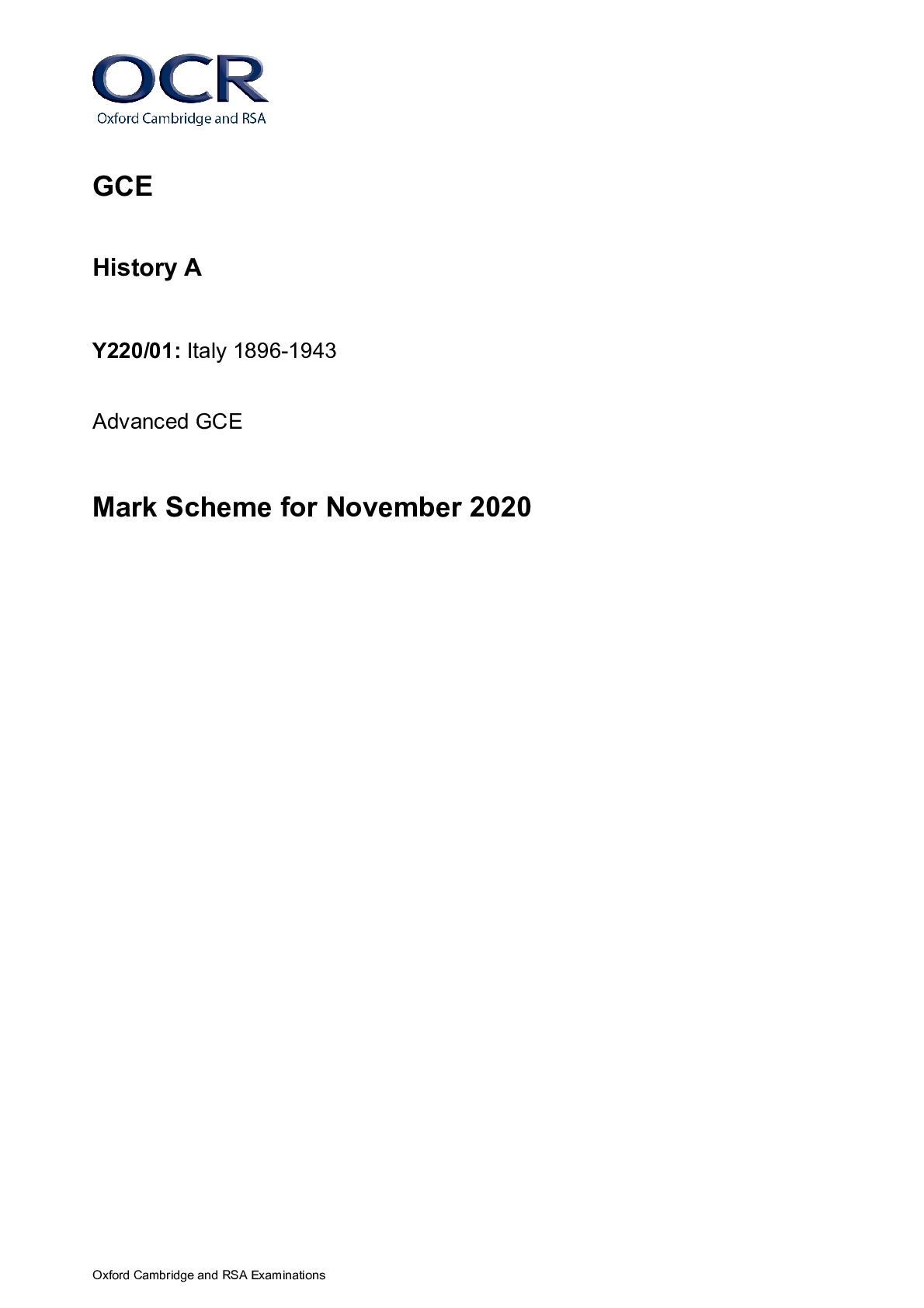

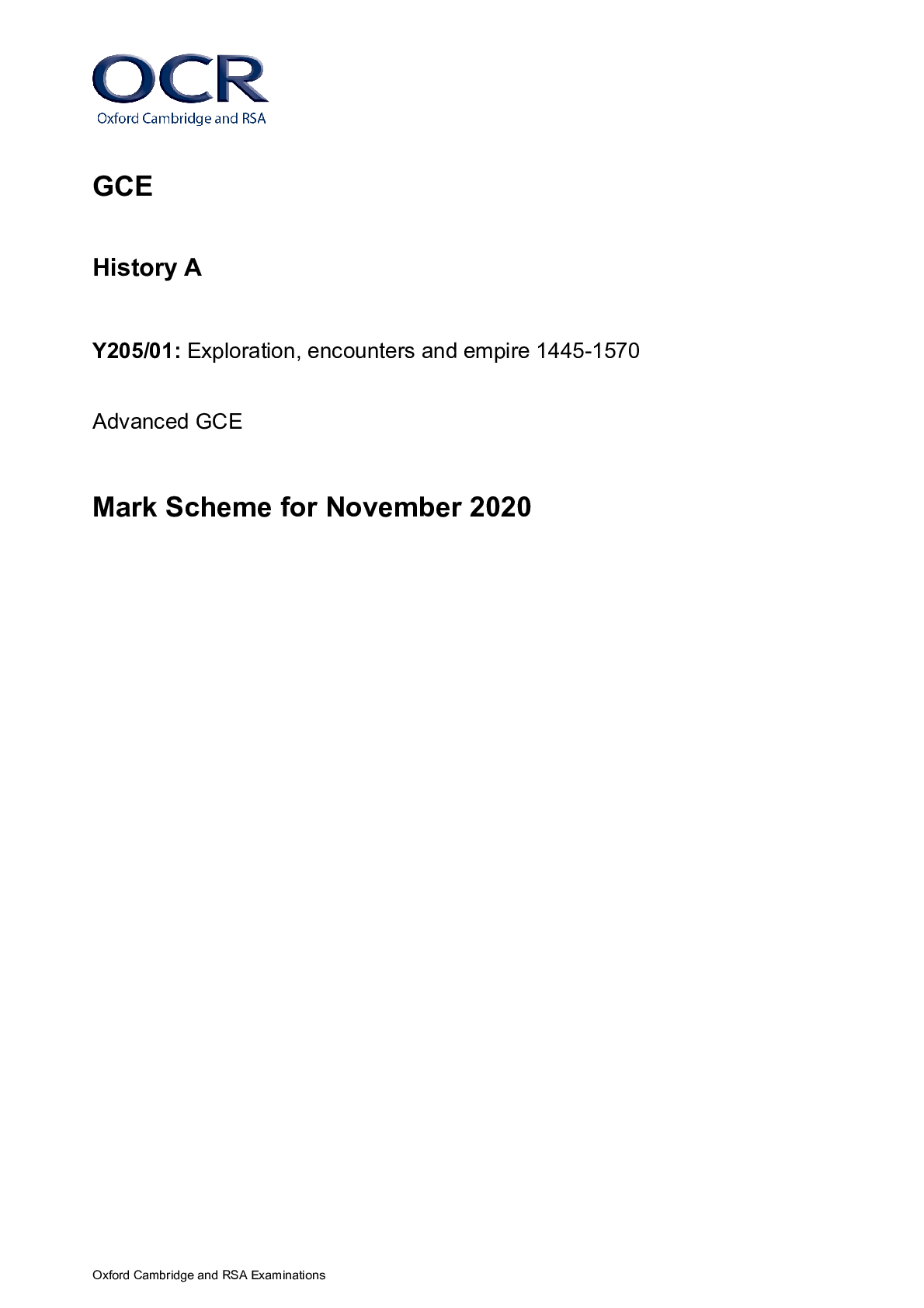
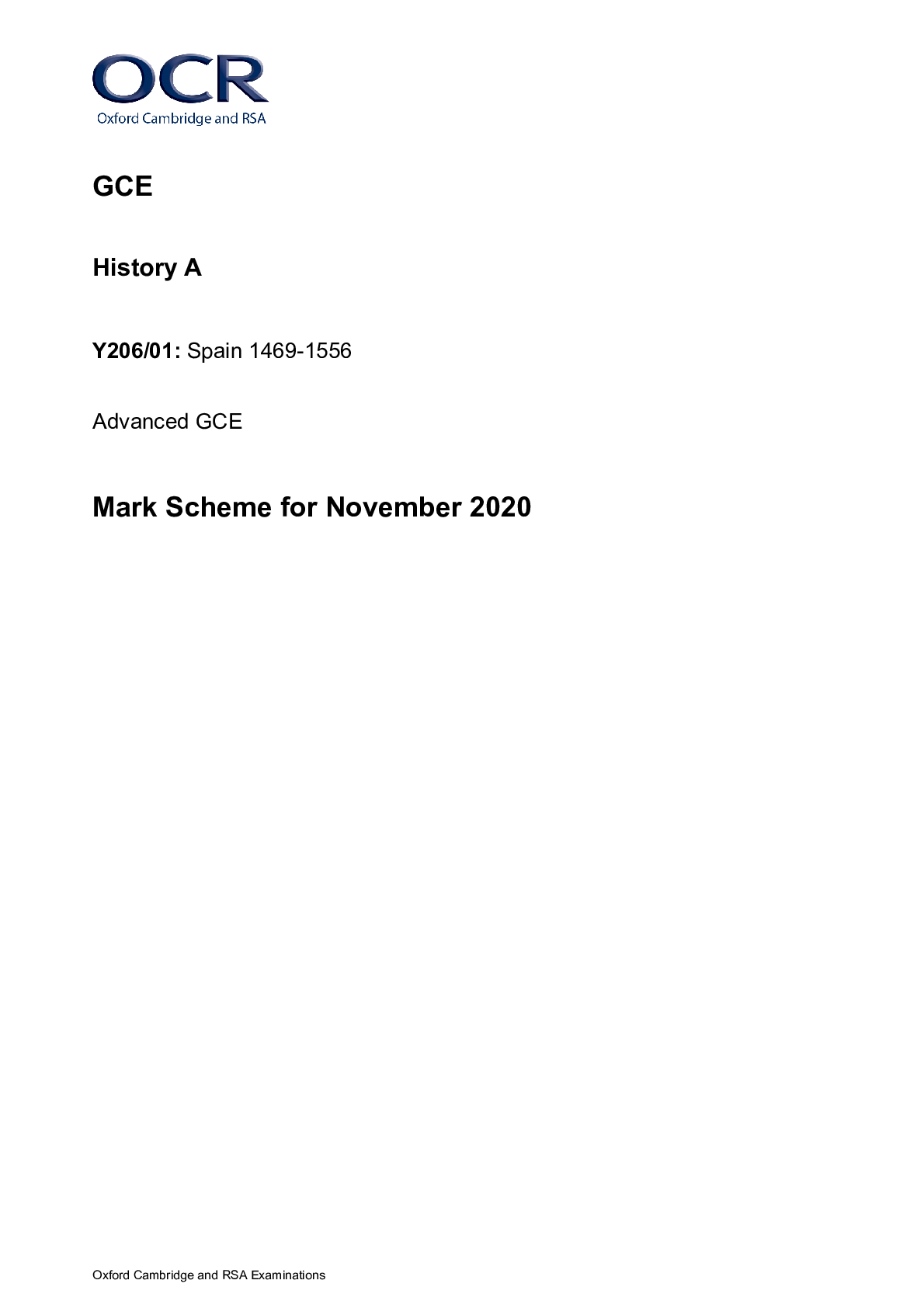
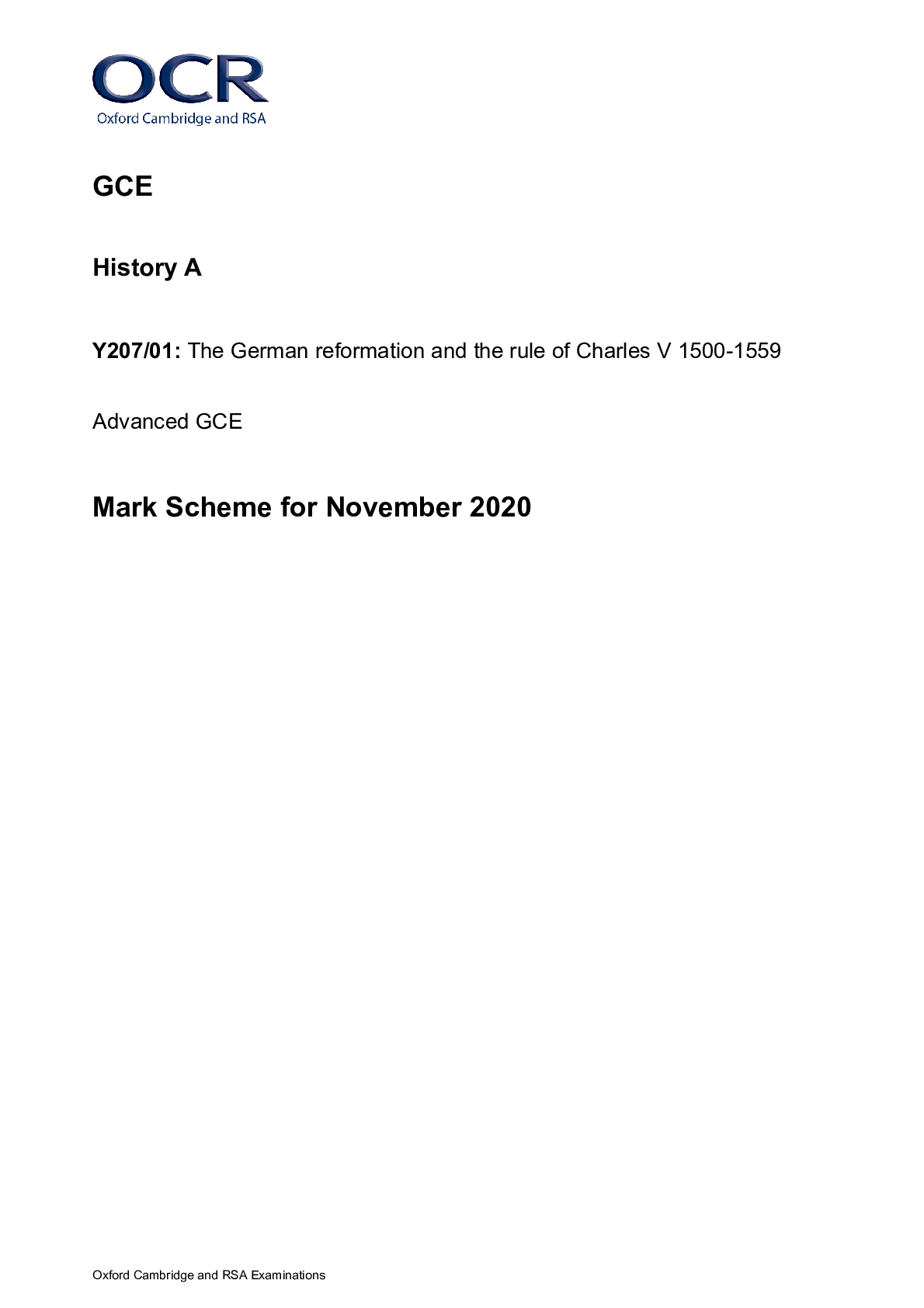
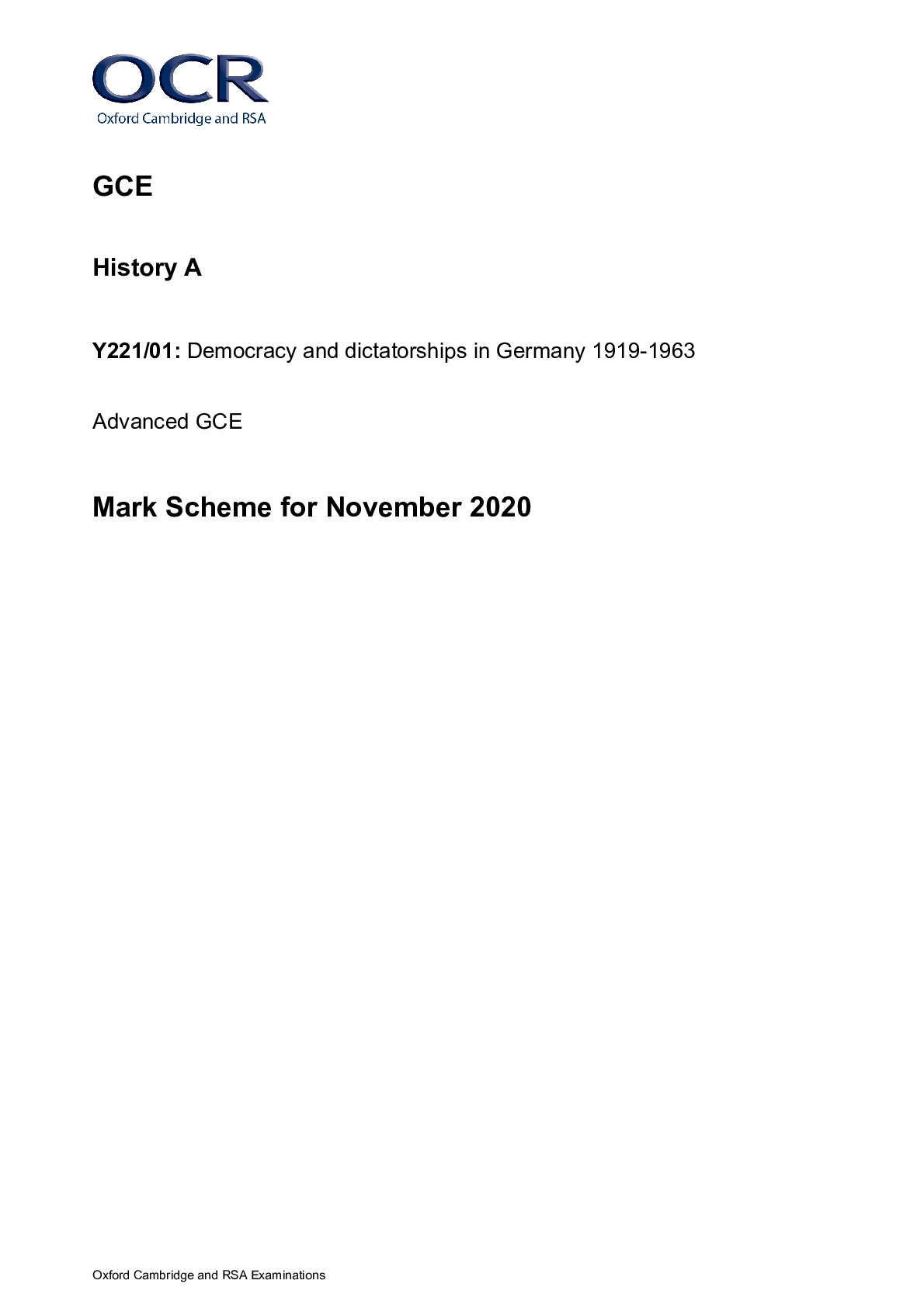

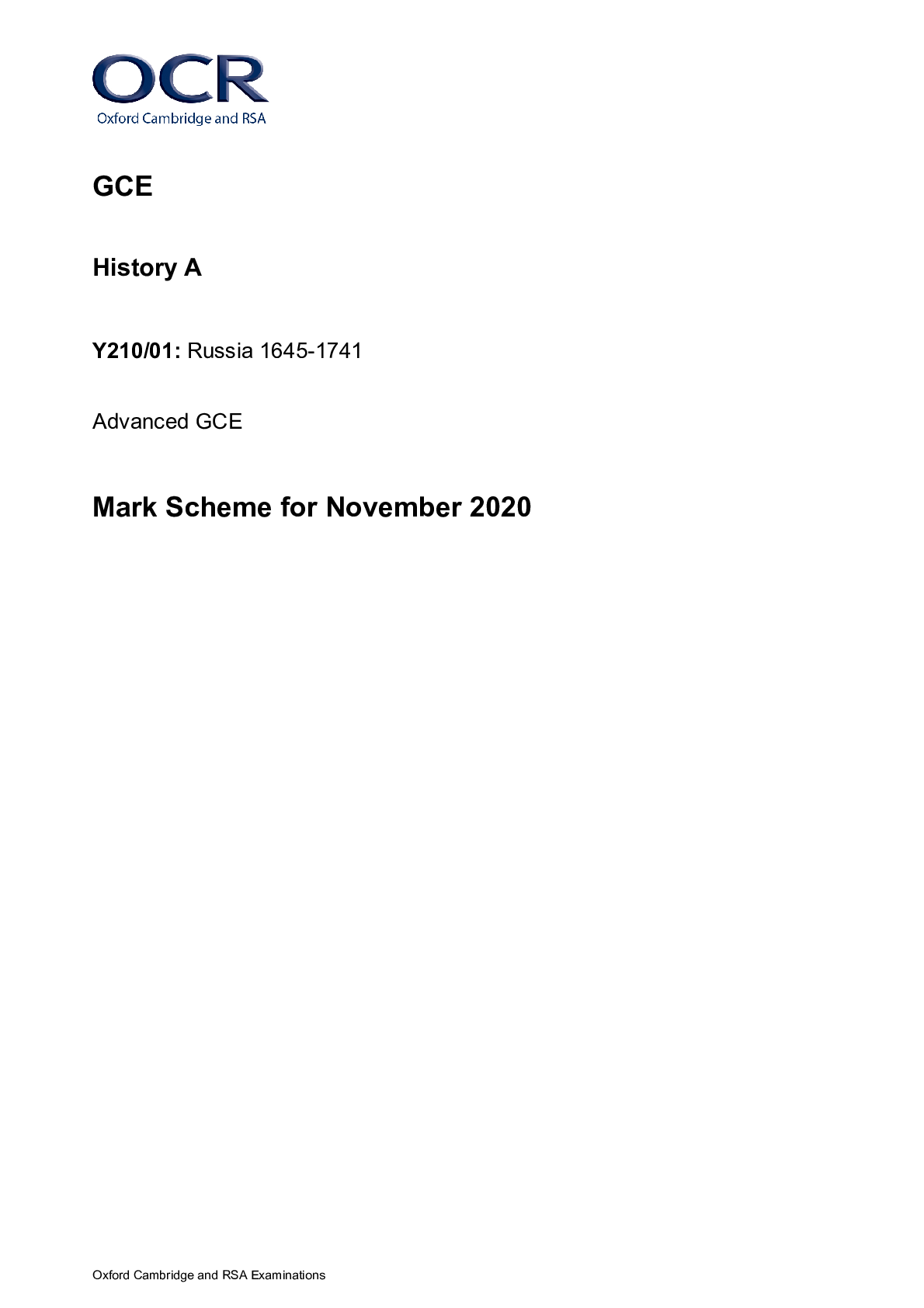


.png)





